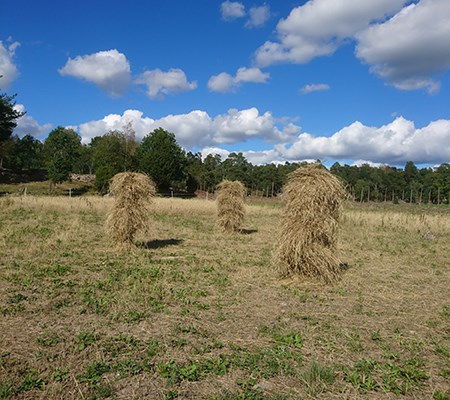Contact

Clas Tollin, Researcher, Division of Agrarian History, SLU +4618671665, +46706091486

One of the objectives of the cultural reserve is to provide good conditions for scientific studies on the usage and living conditions of the late 18th century. The Division of Agrarian History has participated and is participating in several smaller projects at Linnaeus’ Hammarby.
A swidden is a forest area that has been burned to create a field where grain is grown during a shorter period. The fire-fallow method was well spread in Mälardalen from the Middle Ages and onward. On the outskirts of the cultural reserve, swiddens have been established with the aim to understand the biological dynamics and conditions for food production and supply in the older peasant community.
A large part of the cultural reserve was formerly a crown park (hunting grounds owned by the crown). Dwellers in Hammarby and nearby villages were not allowed to collect wood, but were periodically allowed to let their animals graze the land. Around Uppsala, there were a total of ten crown parks. Originally they were hunting grounds for small game. An ongoing study of the crown parks examines their importance for landscape and land use. The project is part of the project Self-management and globalization, funded by the Royal Swedish Academy of Letters, History and Antiquities and SLU.
Parts of the historic fields at Linnaeus’ Hammarby are reserved for historical crops and older farming methods. In September 2018 one plot was sown with an old variety of winter rye, with a rich gene set. The aim is a long-term reuse of the seeds, to develop a Linnaeus Rye adapted to local conditions at Hammarby. The project is part of a larger national project, investigating how the cereals genetically adapt to local conditions.
The construction of the historical vegetable garden began in 2008. It is located on a former allotment and consists of five cultivation beds. The aim is to grow older vegetable varieties in a historically correct manner, as well as to take care of older gene bank material.
Hops contributed to the taste of beer and and acted an important preservative, a quality that was particularly important in the peasant community before the agricultural revolution. During 2009, a part of Hammarby's historical hop garden was reconstructed. It was built on the former location, with clones of older local hop varieties from the gene bank in Julita.
In several areas, mowing with scythes and motor-manual mower is practiced to restore historical meadows. Vegetal changes in the field layer are observed and followed up through a number of permanent plots.

Clas Tollin, Researcher, Division of Agrarian History, SLU +4618671665, +46706091486